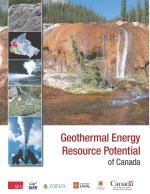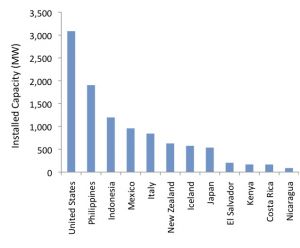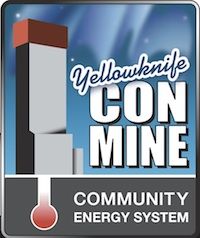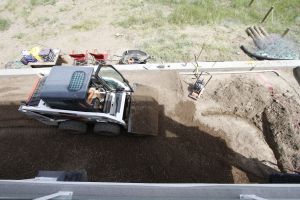
A map of the geothermal resource in Canada from the June 2011 report Geothermal Energy Resource Potential of Canada.
Geothermal energy generates about 10,000 megawatts of the world's electricity, enough to power 10 million homes. But in a world on fire, Sarah McLachlan and the folks at the Canadian Geothermal Energy Association would like to see this number increase dramatically. McLachlan lent her song of the same name to promote geothermal energy in Canada.
The association says Canada alone could generate 5,000 megawatts of geothermal generated electricity by tapping into already mapped heat sources of Earth energy. The association is hosting an annual conference and investment forum in September 2011 to promote the geothermal industry in Canada.
How much geothermal electricity is generated in Canada today? None, zip, nada! There are serious proposals, pilot projects and ideas, but so far none are producing electricity.
 The Geological Survey of Canada released a report in June 2011 on the geothermal resource potential in Canada and found that the in-place potential for geothermal power could exceed one million times Canada's current electricity consumption. However, what will be produced depends on drilling technology, accessibility to transmission lines, and the desire of governments to see the resource developed.
The Geological Survey of Canada released a report in June 2011 on the geothermal resource potential in Canada and found that the in-place potential for geothermal power could exceed one million times Canada's current electricity consumption. However, what will be produced depends on drilling technology, accessibility to transmission lines, and the desire of governments to see the resource developed.
Government policy and financial support has been weak for this industry as evidenced by the fact that Canadian companies - including four listed on the TSX - are building projects in the U.S. and abroad, but not in Canada. In fact, the Canadian Geothermal Energy Association says 27 per cent of the geothermal projects in the U.S. are being built, managed or financed by Canadian companies!
Just as it supports renewable energy much more than Canada, the U.S. government has created a much more favorable environment for this clean energy industry.
What's so cool about geothermal energy?
Geothermal energy is clean energy that produces almost no air emissions and has a very small footprint. It is produced at a constant rate, which means it can provide baseload power that can supplement other forms of renewable energy such as wind, solar or hydro.
Geothermal energy is scalable from a small one megawatt system that serves a small community to a large-scale project that could provide electricity and heat to an entire city.
The highest temperature geothermal resources are in British Columbia, Alberta, Northwest Territories and Yukon. Geothermal systems could be connected to local transmission lines and could provide an alternative to diesel-generated heat and electricity systems in small remote communities.
But as we learned in a report we prepared on geothermal energy for the Northwest Territories (NWT), the Canadian geothermal energy industry is still in its infancy. Despite the high potential for geothermal development, particularly in western Canada, there is no electrical production in Canada as of 2010. Electricity has been produced in the past during tests at the Meager Creek facility in British Columbia, but this 100 megawatt project  was stalled in 2010 and is still not producing energy. A pilot project for production of electricity and heat from oil and gas wells in Swan Hills, Alberta, is under development.
was stalled in 2010 and is still not producing energy. A pilot project for production of electricity and heat from oil and gas wells in Swan Hills, Alberta, is under development.
In spite of a lack of political leadership in Canada, interest in geothermal has started to emerge. The proposed Fort Liard Geothermal Demonstration project will provide one megawatt of electricity and one megawatt of heat to this community in the NWT. The project is a joint venture between the Acho Dene Koe First Nation and Borealis GeoPower. Together they qualified for $10 million to $20 million in funding from the Federal Clean Energy Fund.
A major project is proposed for Yellowknife, NWT. The proposed community energy system would produce 52,000 megawatts per year and heat 40 commercial buildings in downt own Yellowknife. This would offset the use of 7.5 million litres of heating oil per year. The City qualified for $14.1 million in federal support, but its residents would not approve borrowing the money necessary to get the project up and running. The City is working with a private developer and is presently seeking to confirm whether the federal support is still there.
own Yellowknife. This would offset the use of 7.5 million litres of heating oil per year. The City qualified for $14.1 million in federal support, but its residents would not approve borrowing the money necessary to get the project up and running. The City is working with a private developer and is presently seeking to confirm whether the federal support is still there.
The many faces of geothermal energy
So far we have been talking about geothermal-generated electricity, but that is only part of the story. Geothermal heat can be used to produce electricity or it can simply be used to heat the places we live and work or the machines or processes that make things for us.
Geothermal resources are categorized by their temperature range. Throughout Canada, closer to the surface, we have low-temperature heat - 5 C to 12 C just below the surface of the ground - that can be extracted by heat exchangers or heat pumps, called geoexchange systems. Just like the heat pump that takes heat out of your fridge and pumps it into the air, heat pumps can also take low-temperature heat out of the ground and make your house toasty warm.
 More than 30,000 geoexchange systems are installed in residences and 6,000 in businesses across Canada. A system generally costs $20,000 to $25,000 for a home but can pay for itself in 3 to 10 years.
More than 30,000 geoexchange systems are installed in residences and 6,000 in businesses across Canada. A system generally costs $20,000 to $25,000 for a home but can pay for itself in 3 to 10 years.
The deeper the geothermal resource, the hotter the temperatures. High- and medium-temperature resources are used to generate electricity worldwide. Most electricity installations use geothermal temperatures between 100 and 200 C. However, as technology improves and costs go down, we can do more with our lower-quality resources. A project in Chena, Alaska uses water at only 73.3 C to produce electricity that has replaced their polluting and expensive diesel generators. This is the lowest-temperature geothermal electricity production in the world to date.
In addition to temperature, the geothermal resource must be accessible by drilling, and a fluid must be available to carry the heat to the surface. There are different ways to produce electricity depending upon the resource quality.
Geothermal costs low?
The reliability of geothermal energy is one of its best features. The capacity factor, or the reliability of energy production, for geothermal is up to 97 per cent, which is similar to nuclear. Yet it can also be much cheaper and safer to develop. One study in British Columbia put the cost of geothermal generated electricity at 5.09 cents per kilowatt-hour. This was compared to 32 cents for remote diesel, 7.7 cents for small hydro, and 10.88 cents for wind. One could wrestle over the numbers, but suffice to say geothermal energy could be quite competitive.
Time to turn up the heat with geothermal energy
There is a large role for provincial, territorial and the federal governments in helping to develop geothermal resources in Canada. There are many approaches, both fiscal and non-fiscal, that have proven successful in catalyzing Canadian industries, including clear regulations, research grants, renewable energy targets and more. A full national geothermal resource assessment is needed to help identify the best opportunities for geothermal energy projects in Canada. Similar resource assessments, which have been conducted in United States and Australia, can be used as a basis for regional or national planning exercises to identify the areas for the areas for potential development, the economic and environmental impacts of potential projects, and the highest-priority areas for development.
On paper you'd think geothermal energy would be a no-brainer for Canada. The resource exists, the environmental benefits are significant, the costs can be low, it works in remote locations and geothermal energy plays well with new clean-energy grids. Now is the time to turn up the heat on geothermal energy development in Canada.
Peggy Holroyd was director of the Institute's Arctic Energy Solutions group until 2011.



